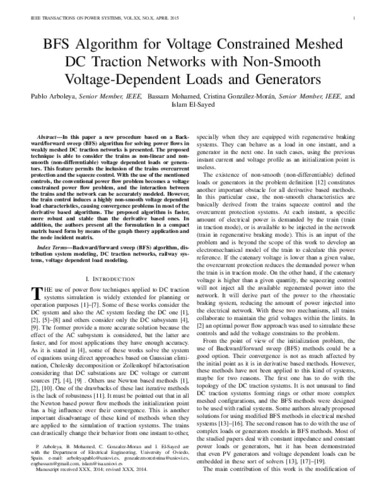Bfs algorithm for voltage-constrained meshed dc traction networks with nonsmooth voltage-dependent loads and generators
Subject:
Backward/forward sweep (BFS) algorithm
Distribution system modeling
Railway systems
Voltage dependent load modeling
Publication date:
Editorial:
IEEE
Publisher version:
Citación:
Descripción física:
Abstract:
In this paper, a new procedure based on a backward/forward sweep (BFS) algorithm for solving power flows in weakly meshed dc traction networks is presented. The proposed technique is able to consider the trains as nonlinear and nonsmooth (nondifferentiable) voltage-dependent loads or generators. This feature permits the inclusion of the trains' overcurrent protection and the squeeze control. With the use of the mentioned controls, the conventional power flow problem becomes a voltage constrained power flow problem, and the interaction between the trains and the network can be accurately modeled. However, the train control induces a highly nonsmooth voltage-dependent load characteristic, causing convergence problems in most of the derivative-based algorithms. The proposed algorithm is faster, more robust, and more stable than the derivative-based ones. In addition, the authors present all of the formulation in a compact matrix-based form by means of the graph theory application and the node incidence matrix
In this paper, a new procedure based on a backward/forward sweep (BFS) algorithm for solving power flows in weakly meshed dc traction networks is presented. The proposed technique is able to consider the trains as nonlinear and nonsmooth (nondifferentiable) voltage-dependent loads or generators. This feature permits the inclusion of the trains' overcurrent protection and the squeeze control. With the use of the mentioned controls, the conventional power flow problem becomes a voltage constrained power flow problem, and the interaction between the trains and the network can be accurately modeled. However, the train control induces a highly nonsmooth voltage-dependent load characteristic, causing convergence problems in most of the derivative-based algorithms. The proposed algorithm is faster, more robust, and more stable than the derivative-based ones. In addition, the authors present all of the formulation in a compact matrix-based form by means of the graph theory application and the node incidence matrix
Collections
Files in this item




